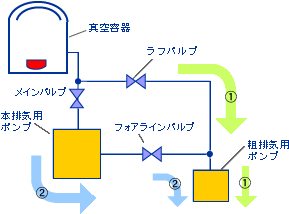Story about Thin Film Vacuum Coating System ②
About the mechanism of thin film vacuum coating system
-How to make a thin film with few impurities and high adhesion?
How to form a thin film?
As a method for forming a thin film, vacuum film formation technology generally includes physical vapor deposition (PVD) using physical movement of particles and chemical vapor deposition (CVD) using chemical reaction. ) are of two types. Here, let us briefly explain the vapor deposition method and the sputtering method, which belong to the former.
Vapor deposition is the simplest method of forming a film by heating, dissolving, and evaporating a film material in a vacuum, as shown in (a), and attaching it to an object. It can be likened to the phenomenon that the steam rising from the bath turns into water droplets on the ceiling.

On the other hand, the sputtering method first applies a voltage of several hundred volts between the vacuum vessel and the electrode (target) made of a film material, as shown in (b). At this time, if a small amount of inert gas (such as argon) is introduced, an electric discharge will occur, and the gas particles will be positively charged by the energy generated. Positive particles are attracted to the negative electrode with a very strong force and collide with the electrode. Part of the film material turns into particles with this force and bounces off, creating a film on the object.
For example, when gas in an old fluorescent lamp collides with the filament (the heat-generating and light-emitting part of an incandescent lamp, etc.) due to discharge, and part of the filament adheres to the inside of the glass tube, the end of the fluorescent lamp turns black. discoloration. This is also considered a type of sputtering deposition.
How to make good quality thin film?
However, with this alone, it is not possible to create a high-quality thin film with few impurities and high adhesion. The point is to keep the inside of the container in a vacuum state during film formation.
For example, when a film is formed in (a) the atmosphere or (b) a low vacuum, even if the particles of the thin film material try to move toward the object at the top of the container, water vapor, oxygen, nitrogen, or carbon dioxide in the air Because particles such as these get in the way, they do not easily reach the target, and a film cannot be formed. In addition, even if the particles of the thin film material reach the object, it will only form a thin film with weak adhesion, or the thin film material will combine with other substances in the air and change in quality. can happen. Therefore, as shown in (c), by creating a high-vacuum state inside the container and reducing the excess components contained in the air as much as possible, it is possible to create a high-quality thin film with little impurities and good adhesion. .

How to make a vacuum?
Thin film vacuum coating system is a device that forms films in a vacuum container based on this principle, and consists of a vacuum container, vacuum pump, and valve as shown in the diagram below. However, there are currently no pumps that have the ability to exhaust the air in a vacuum container from the atmosphere to a high vacuum all at once. We prepare two types of pumps (less than a few Pa). At first, only the rough valve is opened and the rough exhaust pump is used to exhaust the air. Next, close the rough valve, open the remaining two valves, and perform exhaustion using two pumps in series: the main exhaust pump and the rough exhaust pump. Only then can the pressure inside the vacuum container be reached to allow film formation.

This is the mechanism of thin film vacuum coating system.





